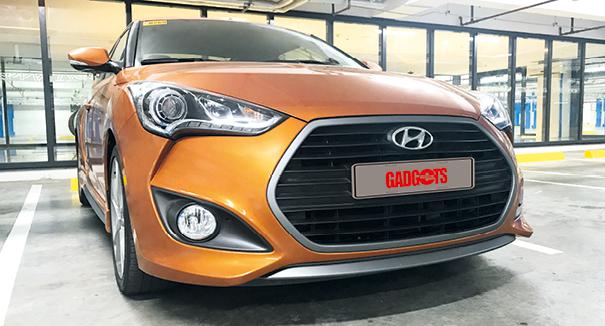Targeted at the younger millennial crowd, the Hyundai Veloster Turbo is one of the more distinctive vehicles in the Philippine market today. It’s good-looking on the outside, but how does it feel on the road?
Design: 4.0/5.0
The Hyundai Veloster Turbo is described as a kammback coupe with an asymmetrical door configuration. The kammback is a design where the smooth car body ends abruptly in a tail that is cut off, thus reducing drag and improving aerodynamics. The Veloster has one large door on the driver’s side and two smaller doors on the passenger side. A panoramic sunroof brings in a more open feel.
From the front, Hyundai’s distinctive hexagonal radiator grille topped by HID projection headlamps and character lines on the hood exude a bold presence. From the side, its silhouette is characterized by a sloping roof for a sporty stance, enhanced by special low-profile tires mounted on 18-inch alloy wheels with chrome inserts. A spoiler, dual exhaust pipes, and a Turbo emblem at the rear put the exclamation mark on this car’s market positioning.
Inside are leather seats and trim, with a power-adjustable driver’s seat with lumbar support. There is seating for only two people in the rear, as the center portion of the rear bench seat is taken up by a small tray for knickknacks and dual cupholders.
Hardware: 3.5/5.0
The Hyundai Veloster Turbo’s engine is a 1.6-liter turbocharged gasoline direct injection (T-GDI) powerplant that develops maximum output of up to 204 ps at 6000 rpm and torque of 275 Nm. This is mated to a seven-speed dual clutch transmission controlled via a gated shift stick combined with steering wheel-mounted paddle shifters. Also conveniently located on the steering wheel are audio, Bluetooth, and cruise control buttons. The suspension system consists of front MacPherson struts and rear coupled torsion beam axles, while disc brakes are installed on front and rear.
The instrument panel is inspired by the
dual-cylinder look of a motorbike’s twin exhaust and, on top of the usual speed/rpm and other indicators, provides the following additional information: fuel consumption, average vehicle speed, distance to empty, and elapsed time. A 7-inch touchscreen display in the center of the dashboard provides convenient access to
multimedia functions, including a back-up camera for parking convenience.
Safety features include dual front, side, and curtain airbags, plus anti-lock brakes, electronic stability program, hill-start assist, burglar alarm, immobilizer, and child door locks.
User Experience: 3.0/5.0
When I first saw the Hyundai Veloster Turbo sitting in my parking slot, I was struck by its distinctive and youthful styling. This was a car that deserved to be seen in the posh sections of the city, so I was happy that I needed to drive to a meeting at the premium business district.
Without having to scrounge around in my purse for the smart key, all I had to do was switch on the ignition by pushing the start button located in the center console just above the gear stick. Then, some fiddling with the power buttons to adjust the leather-clad driver’s seat, the side windows, and the rear view mirror, and I was good to go.
With the fully-automatic climate control system, I only had to set it to my desired temperature once, and I was assured of a cool, comfortable ride each time. Finding controls for heated front seats was an unexpected treat—great for easing tired back muscles when caught in traffic.
A premium speaker system which includes a central speaker, external amplifier, and subwoofer, in addition to six speakers, delivered great sound quality. The problem was that the multimedia controls on both the touchscreen and steering wheel were buggy, so selecting a program or radio station was a hit or miss thing.
Finally, the driving experience. At speed, the Veloster Turbo is a nice drive, but since most of my driving was done in stop-and-go traffic, I had to deal with jerky acceleration which I attribute to the double-clutch transmission gear-seeking between second and first gear. The suspension is also a bit stiff, so you do feel the uneven road surfaces of our city streets.
Value: 3.0/5.0
The Hyundai Veloster Turbo does not come cheap, with a sticker price of PHP 1,608,000. Except for lucky millennials with wealthy parents, the outlay would be well beyond the bank accounts of its supposed target market. Moreover, at that price point, there are other worthy competitors out there with comparable specifications and better pedigrees.
What about long-term cost of ownership? As a first-generation model, it’s hard to predict how the Veloster Turbo will age and what issues may arise with normal wear and tear, but it helps that Hyundai has a five-year unlimited mileage warranty covering electronics or electrical components, powertrain, dual clutch transmission, as well as body and paint.
What about resale value? Again, hard to tell as it’s targeted at a very niche market. Depending on the reputation it gains among local enthusiasts, a first owner must be prepared to take a bit of a hit in the secondary market when it’s time to upgrade.
What’s Hot:
– Distinctive design
– Heated front seats!
What’s Not:
– Audio controls are buggy
– Some jerkiness in the lower gears
Bottomline:
If you dare to be different, this is the car for you.
Also published in GADGETS MAGAZINE November 2017 Issue.
Reviewed and Photos by Maribelle Alba



